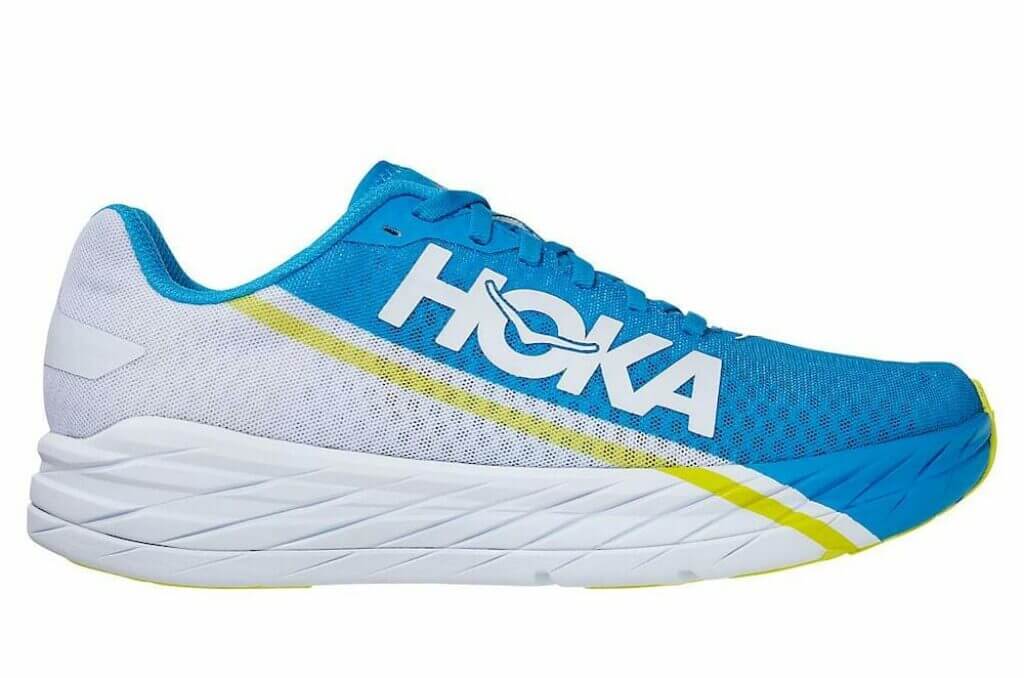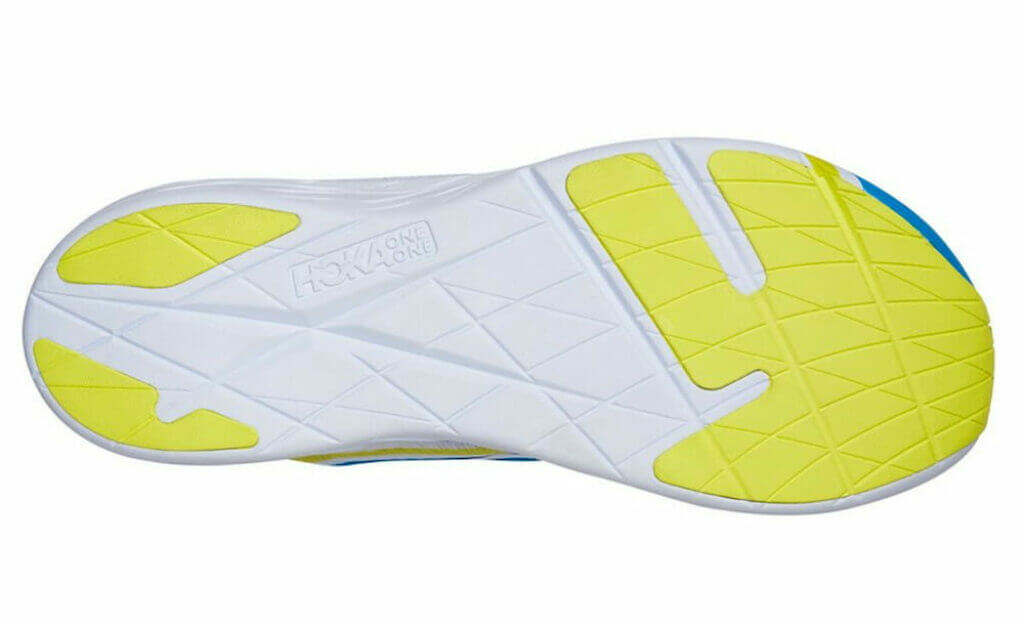Hoka Rocket X Review Analysis (2022)

Last update: April 2024
The Hoka Rocket X is a good carbon-fiber plate racing shoe with a firm cushioning built for speed.
The Consensus
First of all, the Hoka Rocket X is closer to a classic racing shoe than a carbon plate model. The semi-rigid carbon-fiber unit is unobtrusive and offers good bounce without the “trampoline” effect of other carbon shoes—many testers compare the Rocket X to the Saucony Endorphin Pro in terms of the ride but find the latter smoother overall. The CMEVA midsole has a stack height of 32 mm under the heel and 27 mm under the forefoot and offers a simple and effective cushioning, described by testers as firm and moderately springy. It doesn’t have much to do with the signature Hoka plush cushioning. However, it seems that the platform’s firmness and the low drop (5 mm) limit the shoe’s versatility. According to the runners, it takes a quick pace to “activate” the carbon plate’s propulsion benefit. The Rocket X is equipped with Meta-Rocker technology, but it’s not very effective on this model. According to several testers, it’s best to forefoot strike to get the most out of this shoe. However, most runners are heel strikers, which reduces the potential audience of the Rocket X.
Next, the lightweight and breathable mesh of the upper offers precise and flexible foot lockdown: the ideal configuration to combine comfort and race-ready fit. Also, the heel counter is soft and not too high, which will please runners with Achilles problems. The toe box is moderately spacious and should not be a concern for runners with wider feet.
Finally, the rubber outsole is grippy enough despite its seemingly smooth texture and is sturdy enough to withstand wear and tear.
To summarize, the Hoka Rocket X is a good carbon-fiber plate racing running shoe. Still, its particular configuration—which favors forefoot strikers—isn’t versatile enough to rival carbon plate champions like the Nike AlphaFly or the Adidas Adios Pro, especially over long distances. However, it can be an interesting option if you are looking for a simple yet edgy carbon plate competition shoe for short or medium distances.
- Firm and effective cushioning despite the lack of “trampoline” effect
- Well-crafted upper that offers impeccable lockdown
- Discreet carbon plate under the foot
- Good stability for a carbon plate racing shoe
- Good overall durability
- Firm cushioning that lacks responsiveness and fluidity for a carbon plate shoe
- The Meta-Rocker is not very effective on this model
- Lack of versatility (shoe mainly recommended for forefoot strikers)
Technologies

Outsole
- The outsole of the Hoka One One Rocket X uses Zonal Rubber, a sturdy and lightweight rubber that improves durability in high wear parts. This platform also ensures impressive traction on urban terrains.
Midsole
- The CMEVA midsole stands for compression-molded EVA, a single-density padding that gives comfortable cushioning.
- Also, the carbon-fiber plate optimizes stability and responsiveness to speed up comfortably and safely. This technology was first introduced by Nike with its Vaporfly series and was immediately successful in competition.
- Early Stage Meta-Rocker Geometry is a unique technology of Hoka One One that defines the placement of the foam under the athlete’s foot. In the case of the ‘Early Stage’ configuration, the transition zone is under the metatarsals for more fluid transitions from heel to toe.
Upper
- The Hoka One One Rocket X’s upper is an open mesh that provides a comfortable and secure foot lockdown while letting the foot breathe, especially in the summer.
- The anatomical tongue ensures targeted and comfortable foot support.
Facts
Technical Specs
| Terrain | Road |
| Pronation type | Neutral |
| Drop | 5 mm |
| Heel stack height | 32 mm |
| Forefoot stack height | 27 mm |
| Features | Carbon plate, Lightweight, Unisex |
| Weight (men) | 210 g/7.4 oz |
| Weight (women) | 210 g/7.4 oz |
| Release year | 2020 |
| Athletes | Jim Walmsley |
Cushioning
| Softness (1-5) | 2 – Firm |
| Bounce (1-5) | 3 – Moderate |
Technologies
| Outsole | Zonal Rubber |
| Midsole | CMEVA, carbon-fiber plate, Early Stage Meta-Rocker Geometry |
| Upper | Open mesh, anatomical tongue |
Use
| Speed | Fast |
| Distance | Short, mid, 5k, 10k, half marathon |
| Workout | Competition, speed |
Reference: Hoka Official
Did you know?
Since 2017, we have analyzed hundreds of road running shoes, and every month thousands of runners trust us to find the perfect pair!
Discover our selection of the best 2022 road running shoes.
Comparisons – Hoka Rocket X vs.:
Hoka Carbon X
Despite its thicker sole, the Carbon X offers an even firmer configuration than the Rocket X. The choice is primarily a matter of personal preference. Check out the side-by-side comparison.
Saucony Endorphin Pro
The Saucony has a firmer cushioning but also a more springy bounce as it features a very smooth and effective “rocker.” However, the outsole of the Rocket X offers a better grip, especially in the rain.
Frequently Asked Questions (FAQs)
Yes, this shoe fits regularly. Indeed, runners who tested the shoe confirmed that it fits true to size. Therefore, you can buy your usual size for running shoes. Having said that, if this your first pair of Hokas, it’s advisable to test them in-store to avoid surprises.
Yes, this shoe should be adapted to everyone. Indeed, it’s a neutral running shoe. Therefore, it is designed to suit all runners independently from their type of pronation. It’s not equipped with stability props to correct the stride and prevent overpronation. At any rate, it should be noted that no empirical data are demonstrating that stability shoe models are more effective than neutral shoes when it comes to preventing injury. Accordingly, we advise that you select your running shoes based on their comfort, which is the most important criterion. TLDR: you can use the Hoka One One Rocket X even if you have overpronation, as long as you find them comfortable.
Yes, these shoes should be adapted regardless of your weight. Indeed, to date, only one study has looked at the causal relationship between the weight of the runner, stack height, and the injury risk. The results showed that minimalist shoes could increase the risk of injury for runners who weigh more than 157 lbs (71 kg). Otherwise, they were no red flags with other types of shoes. The Rocket X has a stack height of 32 mm under the heel, so it’s not a minimalist shoe (quite the contrary!), so it should be fine even if you’re heavyweight.
This Hoka running shoe has been developed especially for marathon running. Jim Walmsley, the American athlete, specialized in ultramarathoning, is sponsored by Hoka and wears it in official races. However, several testers found that its firm cushioning may not be suitable for everyone for the marathon. It’s up to you, depending on your preferences. If you have experience with firm cushioning, then there should be no problem.
